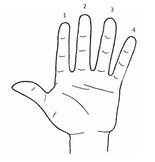Getting Started on the Guitar
As with any instrument, there is so much to learn. If you are going to learn by yourself, where do you start?
Well, you have two hands, and they both have to work...
Well, you have two hands, and they both have to work...
Right Hand
Your right hand will be strumming, keeping the rhythm, and making your playing interesting. To start off with, it is easy just to drag your right thumb across the strings, once for each beat. This is a calming, gentle style of playing.
But kids really love it if you "mix it up" a bit too! Experiment with what your right hand can do, using all of your fingers and fingernails, and develop some nice rhythms. Some rhythms need to have four beats, some three, and some two. Try imitating rhythms you have heard in your favourite music ... and develop your own style. This is something that may take some time - chill with your guitar on your lap and just try different things.
But kids really love it if you "mix it up" a bit too! Experiment with what your right hand can do, using all of your fingers and fingernails, and develop some nice rhythms. Some rhythms need to have four beats, some three, and some two. Try imitating rhythms you have heard in your favourite music ... and develop your own style. This is something that may take some time - chill with your guitar on your lap and just try different things.
Left Hand
Your left hand creates the harmonious chords, so you need to practice forming each chord shape accurately, and changing crisply between chords.
When your fingers are placed (just behind each metal 'fret') in position, they must press hard enough so that as you pluck each string individually you can hear a clear note without 'jangle'!
When your fingers are placed (just behind each metal 'fret') in position, they must press hard enough so that as you pluck each string individually you can hear a clear note without 'jangle'!
Fingering for chords
Many chord charts will indicate (with a number) which finger you should place in each position on the guitar. Pay attention to it and try to do as they suggest - they have been playing longer than you have and they know a thing or two. There is a reason for the finger placement. When you are a expert, then you can decide about changing it.
There is no number for your thumb because you do not use it as part of any chords, it just wraps around the back of the guitar.
What if you are left handed?
Some people go to the trouble of having their guitar re-strung as a left-handed guitar. You could do that. Or you could just adjust yourself. After all, it could be said that the left hand does the hardest part of the work, so maybe you have an advantage.

